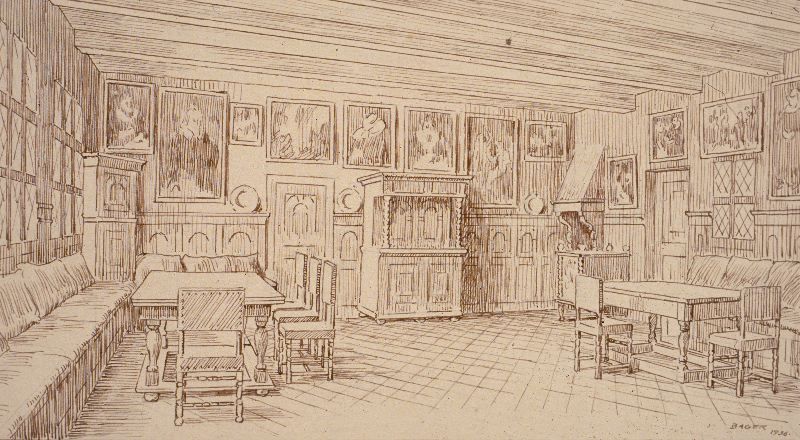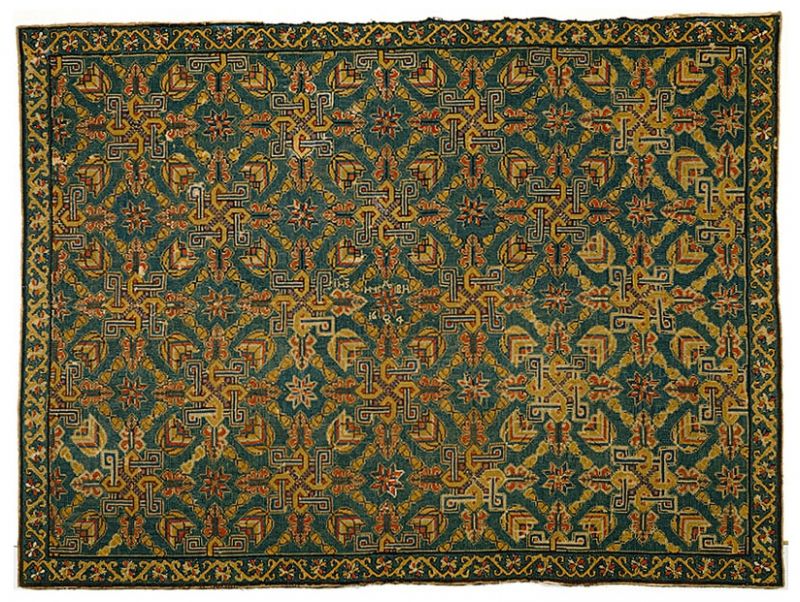ikfoundation.org
The IK Foundation
Promoting Natural & Cultural History
Since 1988


 Crowdfunding Campaign
Crowdfunding Campaignkeep knowledge open, connected, and growing on this textile history resource...
TEXTILE FURNISHING AND EMBROIDERIES
– a Study from 1650 to 1700
For several centuries, Malmö and its nearby districts had benefited from prosperous and long-lasting trade, including the import and export of various textile goods. Circumstances that changed rapidly at the Treaty of Roskilde in 1658, when this wealthy Danish town and other closely situated areas became part of Sweden. The main trade routes were now altered, new taxes were introduced and much of the commerce went via Stockholm, 600 kilometres away. This essay will briefly look into the effects the restrictions of new influences had on Malmö, particularly in the textile trade and handicrafts.
![Part of 17th century map including Malmö [Ellebogen], situated by the Öresund. Undated map of Skåne, printed in Amsterdam. (Private ownership).](https://www.ikfoundation.org/uploads/image/1-malmocc88-karta-jpg-800x514.jpg) Part of 17th century map including Malmö [Ellebogen], situated by the Öresund. Undated map of Skåne, printed in Amsterdam. (Private ownership).
Part of 17th century map including Malmö [Ellebogen], situated by the Öresund. Undated map of Skåne, printed in Amsterdam. (Private ownership).The change of geographical boundaries in the 1650s not only affected the individuals in the 17th century, but it had a substantial impact, even two hundred years later on many traditions. For instance, this was exceptionally well demonstrated in the stagnation of decorative patterns/styles on both clothing and interior furnishing in the farming community. This resulted in Renaissance or even Medieval influences, which, to a great extent, were still present in the 1850s. The situation for Malmö in a new country – located at a lengthy distance from the capital, Stockholm – was not the only reason for an abrupt end to an economic centre. Just as important was the negative effect of King Karl X’s newly introduced high customs tariffs, which almost made it impossible for the import and export of most goods to and from the old areas of Denmark.
Fewer textile remnants have been unearthed from the period 1650 to 1700 compared to previous centuries. Even preserved fragments/garments above ground, which were once locally made or used, are very rare, possibly due to long-lasting wars in the 1670s and frequent fires that ruined entire villages or town districts. Historical documents, therefore, form the most essential knowledge about interior furnishing from Malmö, foremost from the wealthy townsmen’s estate inventories, whose places of residence were around Stortorget or along the main central streets nearby. One of these individuals was the major Söffren Christensen, who lived in one of the larger townhouses, as illustrated below.
 Reconstruction of the living room at major Söffren Christensen’s residence “The Flensburg house” in Malmö 1651, drawn after listed items in an estate inventory by Einar Bager in 1936. Among other interior furnishings, cushions and long bench covers are sketched without revealing any further features of used motifs or techniques. (Courtesy of: Malmö Museum, MHM 007355:011, Creative Commons).
Reconstruction of the living room at major Söffren Christensen’s residence “The Flensburg house” in Malmö 1651, drawn after listed items in an estate inventory by Einar Bager in 1936. Among other interior furnishings, cushions and long bench covers are sketched without revealing any further features of used motifs or techniques. (Courtesy of: Malmö Museum, MHM 007355:011, Creative Commons).A more detailed account will be discussed from another Malmö major – Oluf Knutsson – who died in 1659 (estate inventory dated eight years later in June 1667). The listing of existing possessions at his death gives quite a clear picture of the importance of decorative interior textiles as well as a rich selection of woollen and linen goods. His living room was furnished in the same style as above with long benches fixed to the walls; in this context, it was mentioned: ‘one old Flemish [tapestry] bench cover for the side of the table, 3 dl’. To be an owner of tapestry, woven items were still common in the wealthy townsmen’s homes at this period of time; they were used for benches as well as chair cushions, bedcovers and tablecloths. This tradition was thoroughly documented in the 1960s by historian Ernst Fischer. He stated that tapestry weaving was established in the early 16th century and reached its peak in popularity more than a hundred years later – or around 1650 – for this strata of society. In other words, concurrently with Knutsson’s estate inventory, where two further tapestries were listed in the Loft room: ‘1 Flemish bench cover, 2 dl’ and ‘1 Flemish bench cover with green broadcloth, 4 dl’.
In numerous protocols and listings which described the inhabitants of Malmö, further research has also revealed that women weavers moved from house to house within the wealthy family residences in the early 17th century. One of these professional weavers – producing tapestries was ‘Anne Poffuell Flemish weaver’, which has been able to be traced via the town tax records from 1612. In the later part of the century, estate inventories sometimes included looms for tapestry weaving. One such example is dated 1677 after Sidtzele Hellesdotter, who owned ‘1 tapestry loom, 8s’ and ‘1 horizontal loom, 1 metre [wide]’. Additionally, she left nine ‘Flemish’ tapestries of various sizes, most probably woven on her own loom.
 This is a rare example of a very well-preserved “tvistsöm” embroidery from the late 17th century. The impressive bedcover – dated 1684 – measures 202cm x 150cm and was possibly stitched by one or several women in a wealthy farming family close to Malmö. In an inventory of textiles in 1916, some of its history was described as follows. ‘The bedcover was purchased in the 1880s by the artist Jakob Kulle from Skåne…due to all probability it has its origin from southern Oxie or northern Skytts districts. It is in this small area, where from all “tvistsöm” embroidery seems to have its roots’. Kulle donated the embroidery to the National Museum in 1885. (Courtesy of: Gammal Allmogeslöjd från Malmöhus län, 1916, fig 361, quote p. 171 & National Museum NMK 1018/1885).
This is a rare example of a very well-preserved “tvistsöm” embroidery from the late 17th century. The impressive bedcover – dated 1684 – measures 202cm x 150cm and was possibly stitched by one or several women in a wealthy farming family close to Malmö. In an inventory of textiles in 1916, some of its history was described as follows. ‘The bedcover was purchased in the 1880s by the artist Jakob Kulle from Skåne…due to all probability it has its origin from southern Oxie or northern Skytts districts. It is in this small area, where from all “tvistsöm” embroidery seems to have its roots’. Kulle donated the embroidery to the National Museum in 1885. (Courtesy of: Gammal Allmogeslöjd från Malmöhus län, 1916, fig 361, quote p. 171 & National Museum NMK 1018/1885).Embroideries of this type (or in other woollen stitches) of various dimensions were also part of Oluf Knutsson's estate inventory. These belongings were listed from the living room as: ‘1 stitched bench cover, 6 dl’ and ‘1 tattered ditto 1 dl’. Meanwhile, the ‘1 stitched bench cover’ had its place in the loft room, according to the inventory. It is worth noticing that the embroidered covers were valued higher than the tapestry ones, it is unclear why, as both techniques are equally time-consuming to produce. Fischer’s research mentioned in this context that contemporary estate inventories used descriptions such as: ‘bench cover with damask flowers’ or ‘stitched new bench cover in damask embroidery’. This may be comprehended as the embroiderer copying patterns from the flowery motifs on linen damask tablecloths. As the opposite of weaving – which often was based on professional work in a town environment – embroidery was a popular occupation for the wives, daughters and female house servants of the bourgeois/townspeople in the late 17th century Malmö. The estate inventory of Major Oluf Knutsson also included linen and woollen textiles for the home, possessions which will be discussed in the following essay of this series.
Notice: A large number of primary and secondary sources were used for this essay. Quotes are translated from Swedish/Danish to English. For a full Bibliography and a complete list of notes, see the Swedish article by Viveka Hansen.
Sources:
- Fischer, Ernst, Flamskvävnader i Skåne, Malmö 1962.
- Gammal Allmogeslöjd från Malmöhuslän, Malmö 1916.
- Hansen, Viveka, ‘Fyra sekel Malmö textil – 1650 till 2000’, Elbogen pp. 23-91, 1999.
- Högestads & Christinehof Historical Archive, (Alum Archive, F IIIa 5, Oluf Knutsson’s estate inventory).
- Malmö Museum, Sweden (Online collection, image & information from catalogue card).
- National Museum, Stockholm, Sweden (Online collection, NMK 1018/1885).
Essays
The iTEXTILIS is a division of The IK Workshop Society – a global and unique forum for all those interested in Natural & Cultural History.
Open Access Essays by Textile Historian Viveka Hansen
Textile historian Viveka Hansen offers a collection of open-access essays, published under Creative Commons licenses and freely available to all. These essays weave together her latest research, previously published monographs, and earlier projects dating back to the late 1980s. Some essays include rare archival material — originally published in other languages — now translated into English for the first time. These texts reveal little-known aspects of textile history, previously accessible mainly to audiences in Northern Europe. Hansen’s work spans a rich range of topics: the global textile trade, material culture, cloth manufacturing, fashion history, natural dyeing techniques, and the fascinating world of early travelling naturalists — notably the “Linnaean network” — all examined through a global historical lens.
Help secure the future of open access at iTEXTILIS essays! Your donation will keep knowledge open, connected, and growing on this textile history resource.
been copied to your clipboard




– a truly European organisation since 1988
Legal issues | Forget me | and much more...
You are welcome to use the information and knowledge from
The IK Workshop Society, as long as you follow a few simple rules.
LEARN MORE & I AGREE







